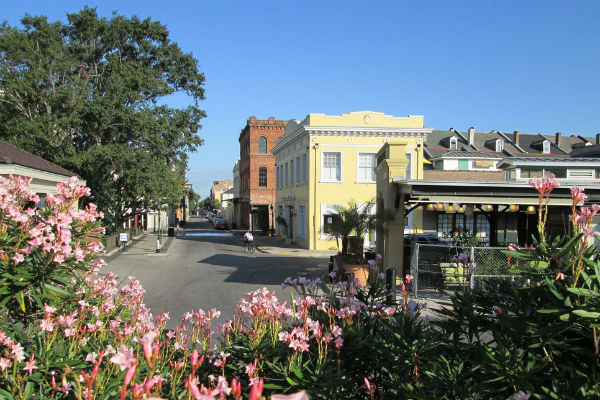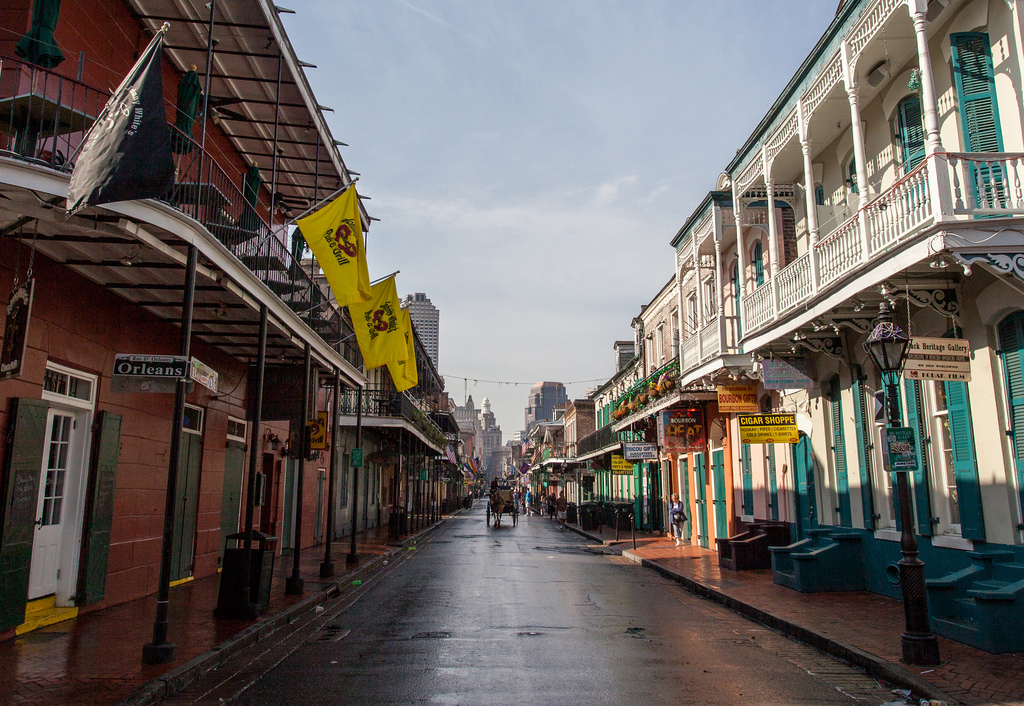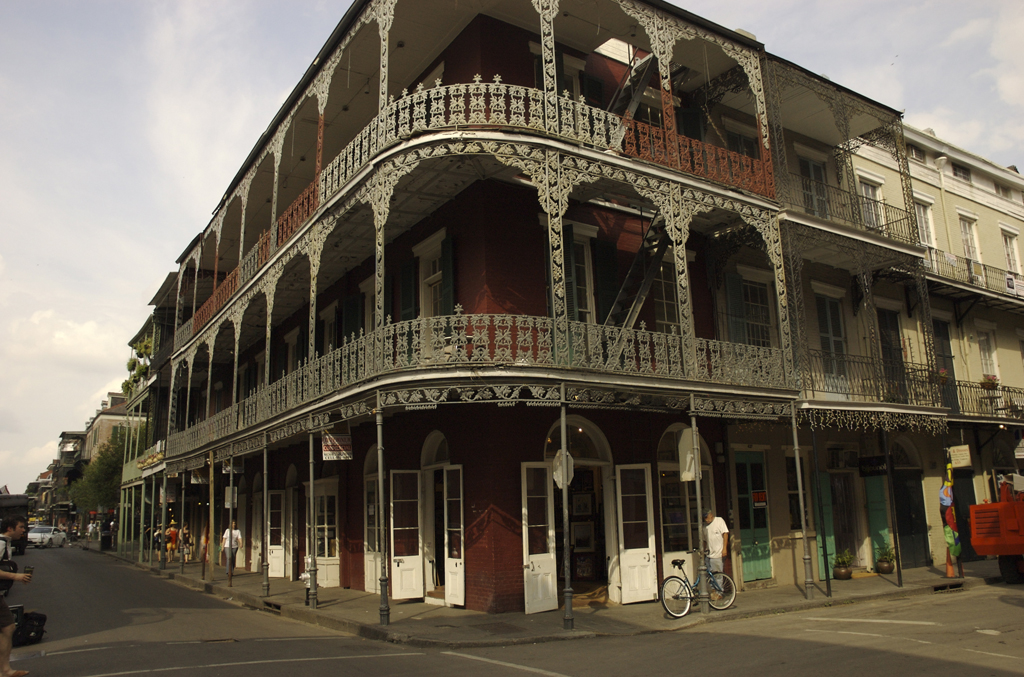There is nothing quite like The French Quarter in New Orleans. At thirteen blocks wide and seven blocks deep, hugging a bend in the Mississippi River, the pulsing heart of New Orleans is best seen by foot. Book a charming hotel or guesthouse in the Quarter and park your car in a nearby garage—you won’t need it in this neighborhood.

French Quarter, New Orleans. River end of Ursulines Street. (Photo: Infrogmation via Flickr)
Brightly-colored Spanish-colonial style buildings line the cobblestone streets, the iron balconies their crowning glory, often boasting a few inviting chairs, a plethora of tropical plants, and a few leftover Mardi Gras decorations. As you stroll the streets you’ll be surrounded by sights and sounds—live music permeating from the bars, street musicians, buskers and tap dancing duos, colorfully-dressed fortune tellers beckoning from almost every corner, street art, horses and carriages—and lots and lots of characters.
The energy and diversity of its inhabitants come from its rich cultural history. During the 18th and 19th centuries, New Orleans dominated the Caribbean as the most active port city for island crops like sugar cane, rum, and tobacco. By the mid 1800s, the city became the fourth largest in the U.S. and one of the richest, dazzling visitors with chic Parisian couture, fabulous restaurants and sophisticated culture. Under French, Spanish and American flags, Creole society coalesced as Islanders, West Africans, slaves, and free people of color poured into the city along with a mix of French aristocrats, merchants, farmers, soldiers, and freed prisoners.
Today, the laid-back locals and tourists from all over mix in much the same way; my husband and I visit often and after a few days we always feel right at home. It’s fantastic to come for one of the great festivals like Mardis Gras, Jazz Fest, or the French Quarter Festival, which is entirely free and features Louisiana-based artists and musicians. Yet we have found that there is always something going on any time of year. Last year we stumbled onto the Open Art Gallery night on Royal Street and Red Dress Run for charity, in which the entire town—men and women alike of all ages—were wearing red dresses, parading and drinking in the streets. While festivals are indeed an experience, quieter weekends give you a chance to enjoy bustling Bourbon Street without fighting crowds, and the side streets are more serene, but never dead—and never dull.
Ambling Down Bourbon Street
When it comes to live music, there is something for everyone on Bourbon Street, from blues to classic rock, from country to zydeco. Pat O-Brian’s courtyard and competing grand pianos may be a bit touristy, but not without reason. Well-known for its large hurricane cocktails and famous flaming fountain, the outdoor garden is quite lovely, while inside you will see double the talent at the dueling pianos, mirrors angled above reflecting the fancy fingerwork even to those seated toward the back.

Bourbon street (Photo: Kevin Byram)
Lafitte’s Blacksmith Shop, on the other hand, is an old ramshackle tavern and piano bar lit only by candles. Further up Bourbon Street, it was built sometime before 1772 and is believed to be the oldest continually occupied bar in the United States. A romantic affair that’s also fun for friends, sit around the piano in near darkness and make requests—and an acquaintance or two in the process.
Find Your Fortune
While out exploring, indulge your superstitious side and venture into one of the old voodoo shops still sprinkled around the Quarter. The practice of voodoo in New Orleans dates back two centuries, to a time when West African slaves arrived; in fact in the mid-1800s, voodoo ceremonies were held every Sunday afternoon in Congo Square. Marie Laveau’s and Reverend Zombie’s are a couple of the most popular, and check out the New Orleans Historic Voodoo Museum. The shops and the museum house relics, dusty displays, skulls and skeletons, and elaborate altars, and sell potions in bottles, spells, voodoo dolls, and ritual candles to cure what ails you.
Head toward the river and hit the French Market. The huge covered market was built in 1791, and with around 200 vendors on any given day, you can get souvenirs for yourself and gifts for others. Choose from beads and masks, handbags and hats, and hot sauce and local spices. Packed with a variety of food stands, the market is the perfect place to sample the street food. We tried the Gator on a Stick—alligator sausage, which was quite good if a little greasy. Afterwards, have a coffee and a French beignet at the famous Café du Monde. For a taste of New Orleans back home, buy some of their canned coffee, made with chicory as is the local custom.
The River’s Edge
Walk west along the river and take a ride on The Steamboat Natchez, the last authentic steamboat on the mighty Mississippi. Lasting about two hours, dinner and daytime cruises are offered, all featuring live jazz. The extraordinary Audubon Aquarium of the Americas is fun for kids and adults alike, and a good place to escape the Gulf Coast heat and humidity to enjoy some air conditioning—even while exploring the depths of the ocean. A 30-foot long tunnel takes you through the Great Mayan Reef and allows views of sea life usually seen only by divers. The museum houses 15,000 creatures, so take time to meet a few of them: perch yourself at Parakeet Pointe, pet a baby shark, let otters entertain you, or stare into the steely blue eyes of a rare white alligator.

The French Quarter’s distinctive Spanish colonial architecture | Photo: Kevin Urke via Flickr
In early evening, stroll down Royal Street. Go for an art crawl on block after block full of galleries interspersed with bohemian boutiques. Gallery Orange opened a couple of years ago and is one of the best, offering a diverse selection of contemporary art including abstract, figurative, folk and pop art. You can check out the talented local artists that the Quarter has long attracted, including the Cajun artist George Rodrigues’s Studio where you’ll see the famous Blue Dog that has become a New Orleans icon. Hundreds of versions of the brightly colored canine in all kinds of vivid settings hang from the walls. Sadly the artist passed away a few months ago, but his dog still lives on in our hearts and in his gallery.
Top the evening off by trying some regional cuisine. No trip to The Big Easy is complete without tasting all the local flavors: red beans and rice, jambalaya, muffulettas, crawfish etouffee, gumbo, and po’ boys. Be warned: the food is spicy. Like the neighborhood itself, there is nothing bland about it.
Once you get a taste for its food, its culture and its people, you’ll be back for more. A unique amalgam of European influence and Southern hospitality, high brow and low brow, this is a place where people still sit on porches and keep their colorful shutters wide open. Wandering aimlessly along these streets, you will probably find yourself—like we did—caught in its magical spell.